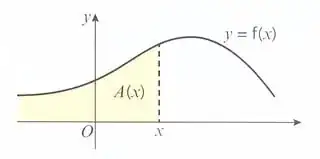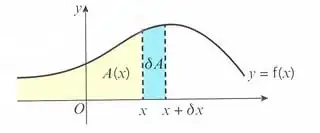So I've been studying integration alongside my class, and the textbook through which we are working contains a very faint reason behind why integration works (nowhere near as rigorous as, for example, why differentiation works) and I was wondering if we could perhaps be shown a stronger proof of why it works.
Here is the proof:
Let $f(x)$ be a function, whose area between the $x$-axis and its curve is given by another function, say $A(x)$, that is
$\implies$ for every increase in $x$, there is a corresponding increase in $A(x)$, denoted by $\delta A$, where $\delta A = A(x+\delta x)-A(x)$, that is
For infinitesimal increases in $x$, call it $\delta x$, the corresponding increase in $A(x)$ will be $\approx f(x)\delta x$ or $y\delta x$ $$\implies\delta A=y\delta x$$ $$\frac{\delta A}{\delta x}=y$$ $$\frac{A(x+\delta x)-A(x)}{\delta x}=y$$ $$\lim_{\delta x \to 0} \frac{A(x+\delta x)-A(x)}{\delta x} =y$$ $$\frac{dA}{dx}=y$$ $$\therefore A=\int y dx$$
I think the main question is: are there any assumptions that have been made that result in glaring errors? Otherwise are there any errors in general? And if so, any suggested improvements are appreciated, thank you.
Edit: I'm pretty sure the greatest flaw would be assuming that a function describing the area between the curve of a graph and the $x$-axis exists, although I don't see how else this idea would have been conveyed without making this assumption.

